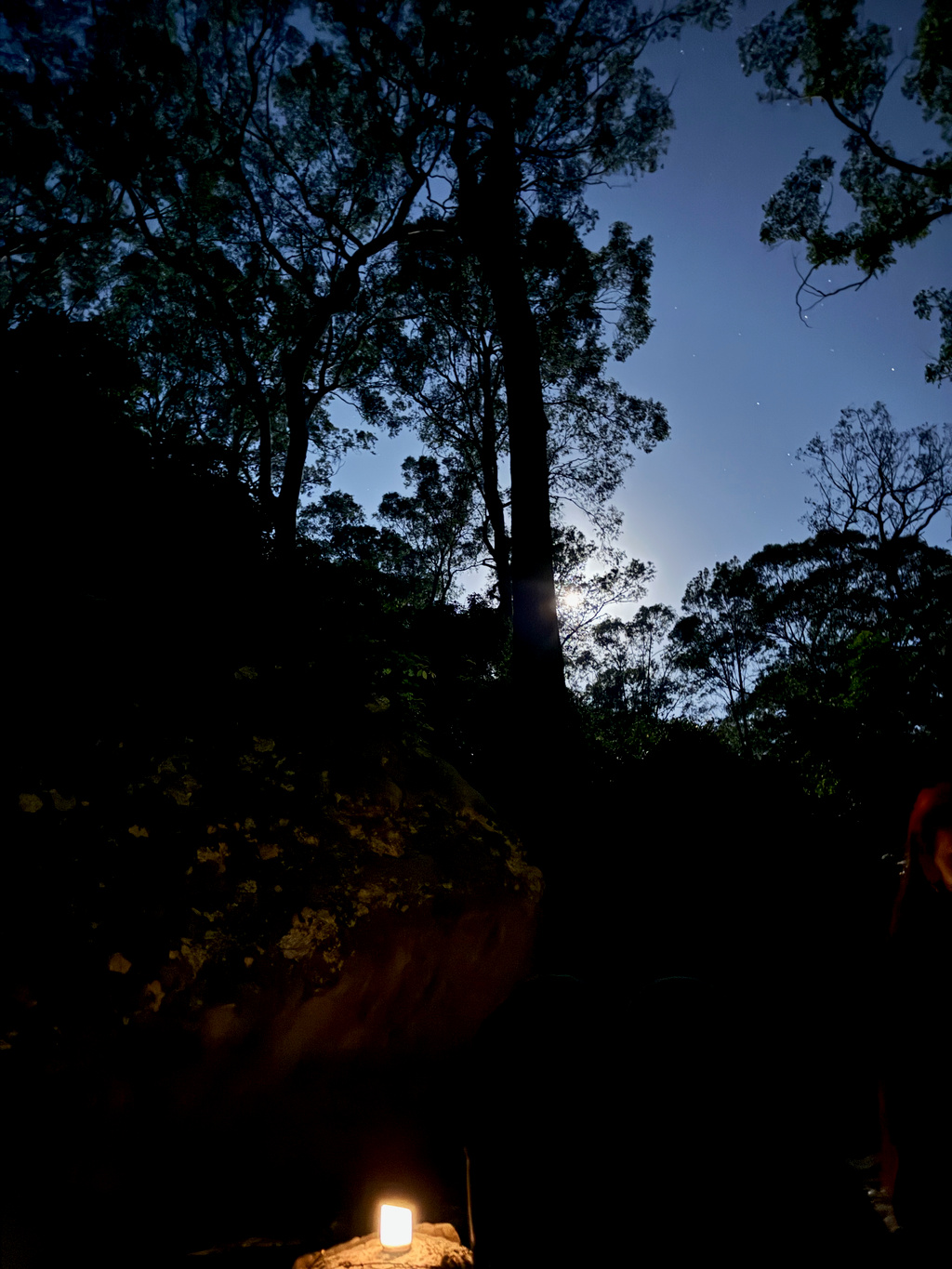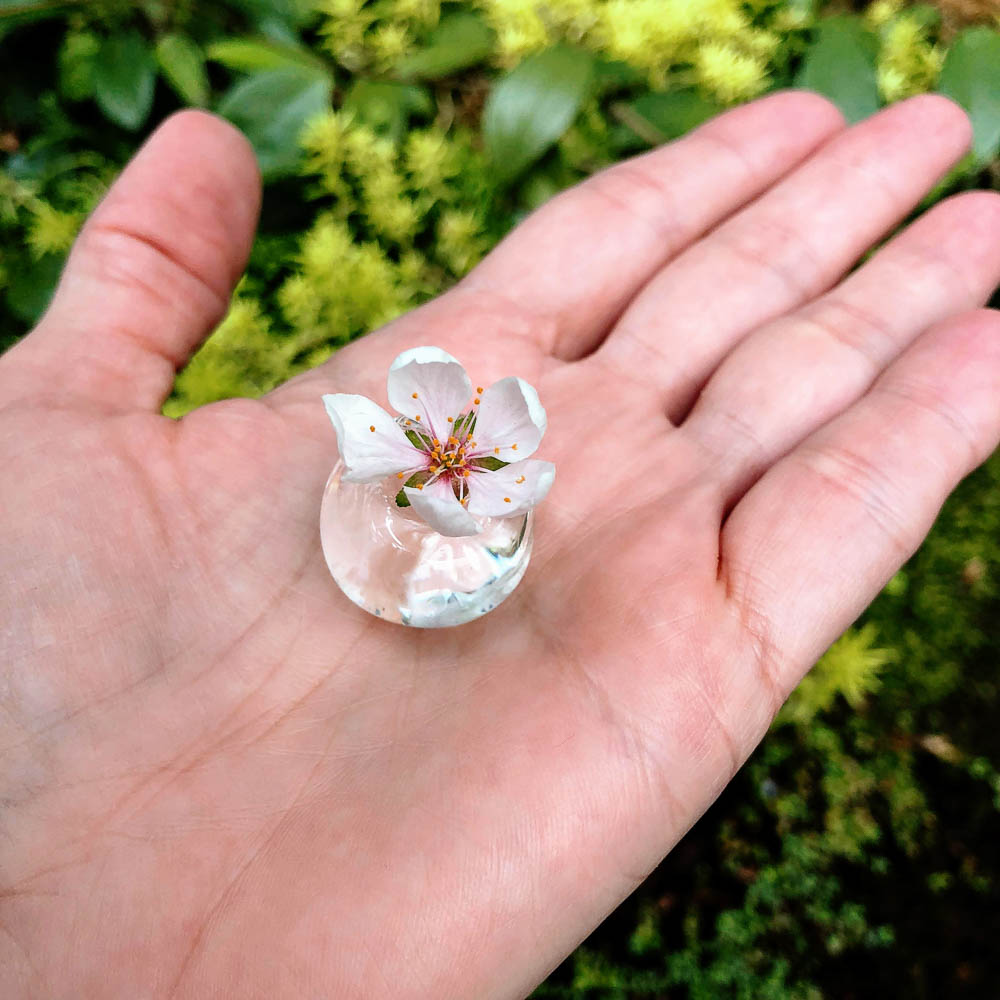Kathryn Bird shares her healing ritual for a collective witnessing of the evening process.
In December 2023, I took part in a Sensorium workshop run by Garland founder Kevin Murray at the Australian Design Centre. As a work of collective imagining under Kevin’s prompting, we focused on a subject—in the case of this first workshop, our relationship with insects—and we constructed a bespoke ritual that enlisted, sequentially and discretely, each one of our senses to meditate upon our subject.
What arose through that afternoon’s communal imagining was the understanding that sensory-focusing actions could be sequenced to create a repeatable Sensorium score for a ritual that could then be reperformed in other places, at other times, by other people.
There was “Buddha’s Tears” tea, with its magical flowering over time, for focusing conversation…
One flow-on effect of that ritual is that I’ve truly never thought about insects in the same way again. But as with the best workshops, the capillary effect was the emergence of a series of recrafting practices and techniques from which other rituals sprang. I was by then eight months into deep mourning for my husband, the remarkable writer and polymath Ross Gibson, who, when I reflected on it, had very clearly developed numerous idiosyncratic meditative sensory rituals of his own. There was a specific incense, “Haku-uan”, to be burned when transitioning into a writing state. There was “Buddha’s Tears” tea, with its magical flowering over time, for focusing conversation (a colleague later related to me that she learned instinctively from Ross that a PHD supervision session must always involve tea as a sensory focusing device). From those two existing RG practices, the taste and smell and touch elements flowed straight into a Sensorium score that I began composing for a Ross Gibson Remembrance Ritual, to be enacted in community to mark a year since his death. Taste and smell were inherent in the tea and incense; touch in the way that Ross would roll the Buddha’s Tears pearls of tea around in his cupped hands before dropping them into the water, leaving the delicate Jasmine aroma on his palms to release subtly as he typed. Sound, too, was easy. The call of a magpie, inarguably the most beautiful sound in the world (one is calling to me this moment as I write!).

Kathryn Bird, “Buddha’s Tears Tea in Vials”, 2024, tea leaves in glass vial, dimensions (each vial 150 x 20 x 20), photo: Kathryn Bird.
I became aware that all of these were unfurling actions: the incense smoke unfurling up into the air, the tight buds of tea unfurling in the boiling water, the magpie calls unfurling to mark the passage of the day. Crucially, these are all elements that have within them their own temporality, which cannot be rushed, only observed. A stick of incense takes about two and a half minutes to burn to ash, the tea takes a few minutes to release: these are meditative increments. A key revelation in that original Sensorium workshop was that the overall ritual draws its force by being bracketed in both space and time, with a defined opening and closing. Shaped by ritual, the unruly and unending pressure of grief might be released, ritually, and returned to, rather than repressed and, by that repression, made enormous and unendurable.
- Kathryn Bird, “Unfurling: A Sensorium Ritual for RG”, 2024, ritual score on paper, dimensions (148 x 210), photo: Kathryn Bird
- Kathryn Bird, “Unfurling Ritual”, 2024, incense, photo: Kathryn Bird
- Kathryn Bird, “Vanessa Berry, Guiding Stars”, 2024, ritual score on paper, dimensions (148 x 210), photo: Kathryn Bird
- Kathryn Bird, “Vanessa Berry, Guiding Stars”, 2024, ritual score on paper, dimensions (148 x 210), photo: Kathryn Bird
The Heavens, the theme of this issue of Garland, are attuned to in the closing of this Unfurling ritual, which was first enacted at the close of day at Ross’s Remembrance, overlooking Sydney Harbour.
Leading into the Sensorium, we had been settled and focused by a deep listening ritual conducted by Ross’s dear friend Gary Warner, called Listening In/Listening Out, a simple communal action that Ross would have loved. Gary asked each of us to find a spot on the balcony to sit to attune ourselves to all the sounds of evening over the harbour for a period of 11 minutes. Gary led into this ritual with his own remembrance about having mused aloud with Ross, overlooking this same harbour from a different vantage, about why this time of day is called the evening. Ross responded that this is the time when everything is evening out, when our eyes are perceiving closeness and distance in a different way, and because our vision is adjusting, our listening becomes more acute.
- Kathryn Bird, “Procession for Unfurling Ritual”, 2024, photo: Zoe Tombs
- Kathryn Bird, Unfurling Ritual , 2024, photo Kathryn Bird
Timing the Unfurling ritual to begin during this evening process introduces, then, the role of The Heavens as the closing for this score. Pictured above are the companion texts to be read aloud to draw the ritual to a close, with the subject and the setting being the night sky. Each passage describes a personal ritual within the larger communal ritual, undertaken lying on our backs looking up into “the sky orbing above”. “Guiding Stars” is a gift from the writer and dear friend Vanessa Berry. “Exercise from Mt Noorat” is drawn from an early and obscure Ross work, discovered after his death. Both describe a private practice of attunement, but in the repeated “performance” of this score—in other times, other places, with other people—I’ve discovered the exponential force of reenacting these simple rituals together. Lying on our backs under the night sky, our heads close, reciting the names of our dead.
So this Unfurling/Night sky ritual is freely released into the world now. It’s yours to perform and customise. It’s shifted my own arts practice and how I share it. Earlier this year I was in residence at Bundanon, on Dharawal and Dhurga country, undertaking a research arts project I called Nocturnal Kinship which centred on my affinity with other nocturnal creatures. I sent these pages to the other artists and writers in residence one afternoon at the end of our time together. I extended an open invitation to perform this score with me in an amphitheatre up in the bush that night, to be reached walking together in the dark with as little artificial illumination as possible.
All the elements of the Unfurling/Night Sky ritual made their way with us up the mountain to the flat rock in a clearing in which we gathered: the magpie calls, the tea, the incense, the recited texts by Ross and Vanessa, concluding with the simple action of lying together on our backs, attuning to the night sky. Only one of this new community of artists and writers in residence had known Ross, but as I’d hoped when composing this score, Unfurling has exceeded its original purpose and it is no longer “about” Ross. Rather, it is a shape put around each participant’s experience of the immensity of feeling that is grief, reflected in the palpable immensity of the heavens above our heads. That evening shared with those artists and writers is crystalline in all of our memories, a transitioning ritual as some participants were leaving Bundanon and others just beginning to embark on their residency. I heard later that one of the artists, the jeweller and field work investigator Michelle Stewart, had extended the invitation to reperform it with the new cohort of residents and it was as meaningful for them as it had been for us.
Ross’s instructions are, after all, simple and perfect, like so much of his writing:
“Lie flat on your back on this cleared ground and gaze at the sky orbing above.
Stay supine like that until you feel the vast heavens pulling you upwards.
Enjoy the odd sense that you could hurtle out into the immeasurable light.”
My thanks to others (human and non-human) who participated, inadvertently or directly, in the development and performances of this work, particularly those who surrounded its original performance at the Ross Gibson Remembrance Gathering on Cameraygal Land and at its reperformance in Bundanon on Dharawal and Dhurga country.
This article is dedicated to the memory of Fiona Winning, who participated in this ritual at Bundanon while on residency to explore her own grief and death in the face of terminal illness.
About Kathryn Bird
 Kathryn Bird works primarily with paper and glue collage on Gadigal land in Sydney. Her work explores the role of archives and collections in communities and has been exhibited in Australia, Belgium, Scotland, and the United States. She is the founder of The Social Glue of Sydney, a communal collage group that is leaderless and open to all. Bird’s recent projects include “Tidal Boundaries,” a series of environmentally responsive works created during a residency at Woollahra Gallery, and “Nocturnal Kinship: Bird to bird,” a research-based project at Bundanon that examines interspecies relationships of kinship and personal grief. Visit prettyshakecollage.com.au and thesocialglueofsydney.com.au and follow @prettyshakecollage.
Kathryn Bird works primarily with paper and glue collage on Gadigal land in Sydney. Her work explores the role of archives and collections in communities and has been exhibited in Australia, Belgium, Scotland, and the United States. She is the founder of The Social Glue of Sydney, a communal collage group that is leaderless and open to all. Bird’s recent projects include “Tidal Boundaries,” a series of environmentally responsive works created during a residency at Woollahra Gallery, and “Nocturnal Kinship: Bird to bird,” a research-based project at Bundanon that examines interspecies relationships of kinship and personal grief. Visit prettyshakecollage.com.au and thesocialglueofsydney.com.au and follow @prettyshakecollage.











Comments
Beautiful! I will try this ritual euthanasia the night sky. I love that you included instructions.